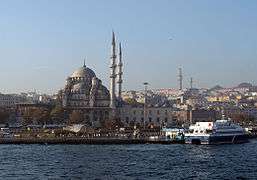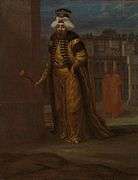Saliha Sultan (wife of Mustafa II)
| Saliha Sultan | |
|---|---|
| Valide Sultan of the Ottoman Empire | |
| Tenure | 20 September 1730 – 21 September 1739 |
| Predecessor | Rabia Gülnuş Sultan |
| Successor | Şehsuvar Sultan |
| Born |
Aleksandra c. 1680 Constantinople, Ottoman Empire |
| Died |
21 September 1739 (aged 58–59) Constantinople, Ottoman Empire |
| Burial | New Mosque, Eminönü, Istanbul |
| Spouse | Mustafa II |
| Issue | Mahmud I |
| Religion | Islam, previously Greek Orthodoxy |
Saliha Sultan (fully Daulatlu İsmatlu Saliha Valida Sultan Aliyyetü'ş-şân Hazretleri; c. 1680 – 21 September 1739) was the consort of Ottoman sultan Mustafa II. She was of Greek descent, and was the mother of Sultan Mahmud I. She held the title and position of Valide sultan during her son's reign.
Life
An ethnic Greek,[1] she was born as Alexandra.[2] She was the adoptive daughter of a family living in the Galata neighbourhood of Azapkapı. At the age of fifteen , while she was filling her water pot from a fountain near the gardens of the imperial harem , she was spotted by Valide Sultan "Queen Mother" Rabia Gülnuş Sultan , mother of the reigning Ottoman Sultan Mustafa II. Saliha dropped her pot on the floor upon seeing the glorious procession of the Queen Mother. The Valide got down from her carriage and talked to Saliha , who was very nervous at first , but then gained self confidence and spoke to her Queen. The Valide was impressed by Saliha's confidence and smart answers , as well as her apparent beauty. The Valide knew from the conversation that Saliha was originally a Greek girl who was adopted as an infant by a poor family. The Queen Mother decided to take the girl with her to the imperial harem , teach her the rules of the palace , and then present the young girl to her son , the Sultan. Saliha was taken to the palace , where she received education in the harem department and converted to Islam. After one year , she was presented as a concubine to Sultan Mustafa II , who was captivated by her beauty and intelligence. She bore Mustafa his eldest son , the future Sultan Mahmud I , thus holding the title of Başkadınefendi , which means chief consort . Saliha was one of the two favorite consorts of Mustafa , the other one being Afife Kadın. Saliha requested a fountain to be built in her name , and the Sultan granted her request , and indeed built a well constructed fountain for her. On 28 September 1730, Patrona Halil with a small group of fellow Janissaries aroused some of the citizens of Constantinople, who opposed the reforms of Ahmed III. Sweeping up more soldiers, the chief rebel Patrona Halil led the riot to the Topkapı Palace, demanded the death of the grand vizier Nevşehirli Damad Ibrahim Pasha, and the abdication of Ahmed III. The sultan acceded to the demands, had Nevşehirli Damat İbrahim Pasha executed, and agreed to the sultanate of his nephew, Mahmud I (1730 – 1754), who replaced him in the throne. As a result of this incident, Mahmud I's mother Saliha became the new Valide Sultan and held the position until her death. She was buried at the New Mosque in Istanbul, inside the tomb of Turhan Hatice, the mother of Sultan Mehmed IV.
Gallery
- Her husband, Mustafa II.
 Her burial place is located near the Yeni Mosque.
Her burial place is located near the Yeni Mosque. Her son, Mahmud I.
Her son, Mahmud I.
See also
References
- ↑ Meram 1977, p. 347.
- ↑ İnal & Arşivi 2005, p. 27, "Mahmutun annesi Aleksandra yani Saliha Sultan".
Sources
- Günseli İnal; Semiramis Arşivi (2005). Semiramis: Sultan'ın gözünden şenlik. YKY. ISBN 978-975-08-0928-6.
- Ali Kemal Meram (1977). Padişah anaları: resimli belgesel tarih romanı. Öz Yayınları.
- Peirce, Leslie P., The Imperial Harem: Women and Sovereignty in the Ottoman Empire, Oxford University Press, 1993, ISBN 0-19-508677-5 (paperback).
- Yavuz Bahadıroğlu, Resimli Osmanlı Tarihi, Nesil Yayınları (Ottoman History with Illustrations, Nesil Publications), 15th Ed., 2009, ISBN 978-975-269-299-2 (Hardcover).
| Ottoman royalty | ||
|---|---|---|
| Preceded by Emetullah Rabia Gülnuş Sultan |
Valide Sultan 20 September 1730 – 21 September 1739 |
Succeeded by Şehsuvar Sultan |
